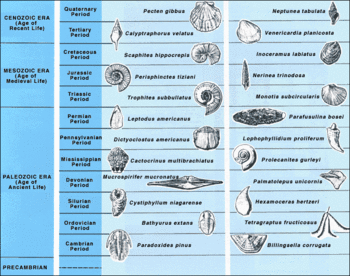

Relative dating is a dating method that used to determine determine the relative ages of geologic strata, artifacts, historical events, etc. This technique does not give specific ages to items. It only sequences the age of things or determines if something is older or younger than other things. Some types of relative dating techniques include climate chronology, dendrochronology, ice core sampling, stratigraphy, and seriation.[1]
Between the years of 1785 and 1800, James Hutton and William Smith advanced the concept of relative dating. Hutton, a Scottish geologist, first proposed formally the fundamental principle used to classify rocks according to their relative ages. He concluded, after studying rocks at many outcrops, that each layer represented a specific interval of geologic time. Further, he proposed that wherever un-contorted layers were exposed, the bottom layer was deposited first and was, therefore, the oldest layer exposed; each succeeding layer, up to the topmost one, was progressively younger. The concept is considered by uniformitarian geologists to be a major breakthrough in scientific reasoning by establishing a rational basis for relative time measurements. However, unlike tree-ring dating -- in which each ring is a measure of 1 year's growth -- no precise rate of deposition can be determined for most of the rock layers. Therefore, the actual length of geologic time represented by any given layer is usually unknown or, at best, a matter of opinion.[2]
William Smith's collecting and cataloging fossil shells from rocks led to the discovery that certain layers contained fossils unlike those in other layers (see: fossil sorting). Using these key or index fossils as markers, geologists began to identify a particular layer of rock wherever it was exposed. Because fossils are believed to record the slow but progressive development of life, geologist use them to identify the relative age of rocks throughout the world.[2]
From the results of studies on the origins of the various kinds of rocks (petrology), coupled with studies of rock layering (stratigraphy) and the fossils they contain (paleontology), geologists have associated layers of rocks with sequence of events thought to have occurred over hundreds of millions of years. For example, it is believed that during a particular episode the land surface was raised in one part of the world to form high plateaus and mountain ranges. After the uplift of the land, the forces of erosion attacked the highlands and the eroded rock debris was transported and redeposited in the lowlands. During the same interval of time in another part of the world, the land surface subsided and was covered by the seas. With the sinking of the land surface, sediments were deposited on the ocean floor. Such recurring events as mountain building and sea encroachment and believed to be recorded in rock layers that comprise units of geologic time. Geologists have divided the Earth's history into Eras -- broad spans based on the general character of life that existed during these times -- and Periods -- shorter spans based partly on evidence of major disturbances of the Earth's crust.[2]
The "relative" positions of layers and fossils to assign estimated dates to strata. Uniformitarian geologists began using the principles of stratigraphy to assign dates to the layers of the geological column fossils back in the late 1700s. Relative dating uses a combination of fossil studies and structural interpretation to draw conclusions about the geological history of an area.
The principles of relative dating for continuous stratigraphic sequences: (as put forth by scientists such as Nicolas Steno):
Ice cores are obtained by drilling core samples of ice in glaciated regions, such as near the poles. Visible light and dark rings can be found in such cores that are then analyzed to determine the age of the ice. These layers are presumed to be the result of annual fluctuations in climate, and using this method, uniformitarians purport to document ages of over 100,000 years. Creationists, such as Michael Oard, contend that these laminations are from subannual events, including layering due to dust to be found in a post-flood ice age. He discusses this theory briefly here. Subannual formation is supported by observations that several such layers of snow and ice can result from the storms within a single winter season.
Dendrochronology is a technique of dating past climatic changes through a study of tree ring growth. Each year a tree adds a layer of wood to its trunk and branches thus creating the annual rings we see when viewing a cross section. Wide rings are produced during wet years and narrow rings during dry seasons. This technique has posed a different problem for creationists, as this dating method does not make use directly of accelerated decay. By using dendrochronology scientists have dated certain living trees to having ages of around 4600 years. This finding showed the current model for carbon-14 dating to be incorrect, so scientists recalibrated their 14C model based on this tree.
|
||||||||||||||||||||